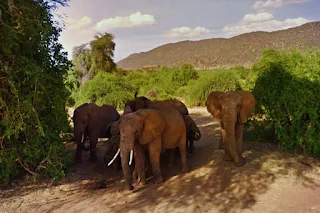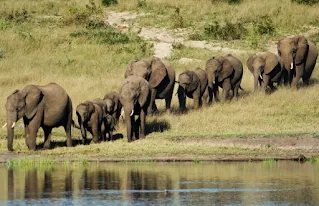Behind a Family of Elephants
African elephants are living natural history
Elephants are intelligent creatures and continue to roam across much of Africa’s Samburu County Mount Kenya where the 1966 movie born free was filmed.

|
| Cinnamon, Celery, and cousins from the Spices family of elephants in Kenya Samburu National Park |
Behind a Family of Elephants
On September 15, 2015, Google released street view imagery of Kenya including the Samburu National Reserve, Lewa Wildlife Conservancy and the David Sheldrick Wildlife Trust. Google street view in partnership with Save the Elephants and the support of the Samburu County governor Moses Lenolkulal allow internet users to take a virtual safari to promote wildlife conservation.
The mission is to let internet users follow the stories of the elephant families in the park. The route follows one of the roads through the 65 sq mile or 165 sq km central Kenyan reserve.
"We hope that by bringing Street View to Samburu, we will inspire people around the world to gain a deeper appreciation for elephants," the AFP news agency quotes Google Kenya's Farzana Khubchandani as saying.
Governor Lenolkulal states "The more people experience our culture, our people and the majestic elephants and other wildlife with which we co-exist, the more we are able to conserve and sustain the Samburu culture and its fragile ecosystem for generations to come," he said, AFP reports.
Elephants are large creatures and their intelligence may surprise you. Elephants are the largest living land animal. The average African elephants are about 10 ft. tall at the shoulder and weigh up to 18,000 lb. the largest elephant in recorded history, however, was 13 feet tall and weighed about 24,000 lb. To sustain this massive weight huge amounts, up to 50 gallons of water and about 220 pounds of food or approximately 70,000 calories are eaten every day.
Elephants are intelligent creatures with the ability to problem-solve with tools but probably the most well-known form of elephant intelligence is their superb memory open migrate from place to place throughout their lives elephants can remember locations of water sources along their migration routes an adult elephant have to consume an enormous amount.

|
| Family of elephants |
At 5,199 meters or 3.2 miles high, Mount Kenya is the second-highest peak in Africa. It is an ancient extinct volcano sacred to the Kikuyu. During Mount Kenya period of activity around 2.8 million years ago is thought to have risen to 6,500 meters.
There are 12 remnant glaciers on the mountain, all receding rapidly, and four secondary peaks that sit at the head of the U-shaped glacial valleys. With its rugged glacier-clad summits and forested middle slopes, Mount Kenya is one of the most impressive landscapes in East Africa. The area also lies within the traditional migration route of the African elephant.
African elephants can be found across central and southern Africa. The largest land mammal in the world, a bull African elephant can weigh more than 13,000 pounds. African elephants are known to travel in family herds with females and their calves staying together for many years.
For centuries, elephants have been hunted for their tusks, either for trophies or for the art of ivory carving and jewelry making. Although the tusks or teeth of several mammal species including warthog, walrus, hippopotamus, and several whales are used as ivory, the tusks from African elephants and Asian elephants are most desired by the global ivory market.
The demand for elephant ivory led to devastating declines in the number of these giant animals, particularly in the 1970s and 1980s. Despite international efforts to control the ivory trade and stop the decline of elephant populations, prices and demand for ivory remain high, resulting in continued poaching of elephants for their tusks. Poaching and habitat loss are the major threats to African elephants today.
In 1978, the African elephant was listed as Threatened under the U.S. Endangered Species Act (ESA). The African elephant was first listed in Appendix III of the Convention on International Trade in Endangered Species of Wild Fauna and Flora (CITES) in 1976 and moved to Appendix II the following year.
In 1990, after nearly a decade during which African elephant populations dropped by almost 50%, the species was moved to Appendix I of CITES. In 1997, some recovering populations were moved back to Appendix II with strict limitations on trade in ivory.
Through the African Elephant Conservation Act, passed in 1988 by the U.S. Congress, the African Elephant Conservation Fund was established and Congress has appropriated millions of dollars to the fund since its creation. On July 6, 2016, a near-total ban on commercial trade in African elephant ivory went into effect in the United States.
Mount Kenya National Park was created in 1949 to protect Mount Kenya and its environment from destruction and development. The Mount Kenya National Park and Natural Forest World Heritage site was inscribed in 1997.
A marked climatic gradient exists between Mount Kenya with its glaciers and snowfields at high elevations in the south and the northern area to Samburu National Park. The southern area experiences the tropical climate of the Kenyan Highlands whereas and northern areas have the semi-desert climate of Eastern Kenya.
The rate of desertification, degradation of water sources including the shrinkage of glaciers on Mount Kenya is accelerating. Climate change is probably one of the most serious long-term threats to the site.
Glaciers are melting fast and appear destined to disappear altogether within a few decades. As the climate warms the vegetation zones can be expected to shift higher up the mountain.
Together we build awareness that boost harmony, education, and success, below are more links to articles you will find thought provoking.
- African Country Names Your Saying Wrong
- What do Waist Beads Symbolize in Africa?
- About African Healers and Witchdoctors
- Hurricanes are Angry African Ancestors
- Highest Temperature and Lowest Temperature in Africa
- About African Night Running

 Since 2007
Since 2007


